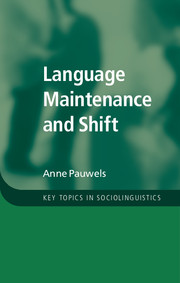Book contents
- Frontmatter
- Dedication
- Contents
- Acknowledgements
- Introduction
- PART I HISTORY, CONCEPTS, CONTEXTS AND APPROACHES
- PART II INVESTIGATING LANGUAGE MAINTENANCE AND SHIFT: COLLECTING AND ANALYSING DATA
- PART III IDENTIFYING AND UNDERSTANDING TRENDS AND PATTERNS IN THE DYNAMICS OF LANGUAGE MAINTENANCE AND SHIFT
- 6 Trends and patterns in language maintenance and shift
- 7 Understanding the dynamics of language maintenance and shift
- PART IV LANGUAGE MAINTENANCE EFFORTS AND REVERSING LANGUAGE SHIFT
- PART V FUTURE DEVELOPMENTS IN THE STUDY OF LANGUAGE MAINTENANCE AND SHIFT
- References
- Index
- References
7 - Understanding the dynamics of language maintenance and shift
from PART III - IDENTIFYING AND UNDERSTANDING TRENDS AND PATTERNS IN THE DYNAMICS OF LANGUAGE MAINTENANCE AND SHIFT
Published online by Cambridge University Press: 05 August 2016
- Frontmatter
- Dedication
- Contents
- Acknowledgements
- Introduction
- PART I HISTORY, CONCEPTS, CONTEXTS AND APPROACHES
- PART II INVESTIGATING LANGUAGE MAINTENANCE AND SHIFT: COLLECTING AND ANALYSING DATA
- PART III IDENTIFYING AND UNDERSTANDING TRENDS AND PATTERNS IN THE DYNAMICS OF LANGUAGE MAINTENANCE AND SHIFT
- 6 Trends and patterns in language maintenance and shift
- 7 Understanding the dynamics of language maintenance and shift
- PART IV LANGUAGE MAINTENANCE EFFORTS AND REVERSING LANGUAGE SHIFT
- PART V FUTURE DEVELOPMENTS IN THE STUDY OF LANGUAGE MAINTENANCE AND SHIFT
- References
- Index
- References
Summary
FOCUSING ON INTERGROUP DIFFERENCES IN LM AND LS
The existence of intergroup or interethnic differences in maintenance or shift rates is probably the most consistent finding emanating from the multitude of studies. Some linguistic minorities or ethnolinguistic groups maintain their language better than other groups, despite being exposed to the same environment. For example, Polish Australians maintain their language more and longer than Dutch Australians in the same Australian environment. Another observation regarding interethnic or intergroup differences in LM or LS rates relates to a specific group managing to maintain its language in very diverse settings. The Greek diaspora around the world is an example of this. Conversely, there are ethnolinguistic groups whose LM or LS rates are quite susceptible to the environment in which they find themselves. This could be said, for example, of Turkish immigrants in Australia in contrast to those living in the Netherlands or Germany. They seem to maintain their language better in the latter countries. It also applies to Basque people living in Basque territories of France and Spain. In the previous chapter we delved into some trends that seem to be common across heritage and territorial linguistic minorities. These related mainly to personal characteristics, i.e., sociodemographic factors, and to the contexts (domains) that promote LM or LS. Here, the focus is mainly on the group level in an attempt to shed light on these intergroup differences. In particular, we review a number of approaches that have attempted to identify factors influencing language behaviour at the group level. In most cases, the models developed are in fact taxonomies or typologies focusing on group factors. Some of these are described as ‘theories’ because their proposers contend that they are able not only to enhance our understanding of specific language-use patterns but also to predict whether a group is likely to maintain its language.
TAXONOMIES OF GROUP FACTORS INFLUENCING LM AND LS
Kloss’ clear-cut and ambivalent factors
One of the first approaches to understanding differences in the language behaviour and language-use patterns of ethnolinguistic groups was Kloss’ (1966) study of German-American language maintenance efforts during the late nineteenth and first half of the twentieth century. In this paper Kloss created a list of two types of factors that contribute to shaping the dynamics of LM or LS. He referred to them as clear-cut and ambivalent factors.
- Type
- Chapter
- Information
- Language Maintenance and Shift , pp. 100 - 114Publisher: Cambridge University PressPrint publication year: 2016

